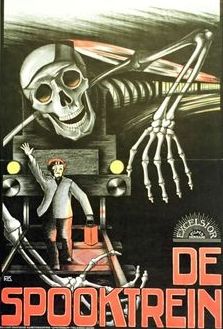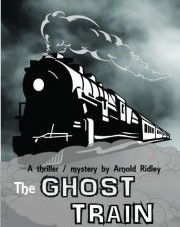
A Joker pulls the emergency cord to stop the train in order to retrieve his hat that had flown out a window. This causes the train to arrive at the station late, and with no other trains coming until morning, stranding a group of passengers. Besides the Joker, the group include a newly Married Couple, a Cute Girl traveling with an Earnest Man, a teetotaling, Prissy Lady with a parrot, and a Doctor. They are warned by the Station Master that the station is haunted and that a ghost train comes by at night, and if they want to survive, they need to leave. They refuse, and the Station Master abandons them in fear of the ghosts. What follows is a string of spooky events, including a death and then the disappearance of the corpse, strange sounds and lights, the arrival of a crazed woman, and the passage of the ghost train itself.

The Ghost Train was a very popular British play. Written by Arnold Ridley in 1923, it had a successful run and has seen numerous revivals. It was adapted for the screen in 1927 in a British-German coproduction, and like so many other Dark House movies, it was remade once sound was in place just a few years later, in 1931, this time just by the British. Next, in 1933, came two from the European continent, the Romanian Trenul fantomă and Hungarian Kisértetek Vonata. The French Un Train Dans La Nuit was released in 1934, but that one will get no more discussion here as no prints are known to survive. In 1939 the Dutch joined in with De Spooktrein. And finally the Brits took it back in 1941. There have been four more official versions since then, and a number more that “borrowed” from it, but I’ll stick with the years from ’31 to ‘41.
It’s surprising how much alike the five surviving films are. The basic plot is exactly the same, with all the same major events occurring in the same order, and with few changes to even the minor ones. While the character names change (I’ll use descriptive names for each), their personalities shift only a bit. Footage is even shared between three of them, and the 1941 version had the same director as the 1931, so perhaps it isn’t that surprising.
The Ghost Train is an Old Dark House story transplanted to a railway station. The characters are properly quirky, there’s a dead body and strange lights and talk of ghosts, plenty of comic relief, and an eerie atmosphere. The story line is entertaining enough, and certainly has been popular. The characters are not complex or deeply developed, but rather were intended to represent a cross section of British society in the 1920s, thus supplying a bit of commentary while also being easy to identify. Everything is here for a thoroughly entertaining film. However, a few flaws are inherent to the structure that have been magnified in different productions. The story is good, but it’s brief, at least as executed in all five films (I’ve never seen the play and am curious how it fills nearly two hours). There’s approximately an hour’s worth of material. When an adaptation gets much over that, it drags. As the story was written for the stage, there’s a tendency to replicate that a bit too closely. I’m not a fan of opening up a film for no purpose when made into a movie, but most of these renditions could be converted back into a stage play without making any changes. A few more locations or some clever manipulation of the camera to better tell the tale would be nice. But inventive cinematography is not in abundance. Also, the Joker is supposed to be annoying to the other passengers, but he can easily become annoying to the audience. And if the film features him as the lead instead of part of the ensemble, as several do, he can become downright unpleasant.
How do the individual adaptations fare?
The Dutch De Spooktrein is more stylish than the previous versions, but then it is 1939, and there had been technological leaps in filmmaking in six years. The station doesn’t look like stage set, but feels real; it’s also spookier. Generally the filmmaking is a step up, and while De Spooktrein show’s its stage roots, the story has finally been given a true conversion for film. And again, this is a shorter film. While it cannot be called swiftly paced, at under 70 minutes, it doesn’t drag. I suspect some of the improvements can be attributed to having a more skilled director: Karel Lamac. He’d been forced out of Czechoslovakia and Germany, so found himself in the Netherlands. This led to the movie getting a mixed reaction in its homeland. The Dutch were feeling nationalistic (hard to blame them with the Nazi’s next door) and De Spooktrein didn’t feel like a Dutch movie to them.
For the first time, there’s been a change to the characters. The Cute Girl and her Earnest Companion have become a Magician’s Assistant and an incompetent Magician. He combines the grouchiness he had in previous versions with a few of the Joker’s antics. He’s also a bit of a coward. While the Prissy Lady hasn’t changed, she has been given a more dominate role in the first section. It’s through her that we meet the other characters (she wants to change compartments to get away from smokers) and it’s the loss of her parrot that causes the train to stop instead of the Joker’s hat. Both of these changes turn out, somewhat surprisingly, to be for the good. The Earnest Man never had much of a character, and although this turns him into even more of a cliché—clearly a figure we are not supposed to like—it gives him a personality, as well as activity. And more of the Prissy Lady makes the outlandish behavior of the Joker more acceptable. She’s so unlikable that his pranks and silliness feel not only acceptable, but the sort of thing I’d like to do in the situation.
While The Ghost Train is, by nature, an ensemble piece, the Joker tends to steal the spotlight. Not so here. This is a much more balanced film. Every character gets a moment to shine, and I knew them all much better when it was done. While the ending is essentially the same, more characters are involved with what happens, which gives it the most satisfying climax, and makes it a satisfying adaptation.
Which makes 1939’s De Spooktrein the version to see. Follow that up with Kisértetek Vonata. For English-only speakers, it’s time for subtitles, or read the play first and muddle through.





 steals the film. Hentzau is suave, witty, and playful. He jokes as he kills. He’s more than happy to run from a fight, but not because he is a coward; he simply sees no reason to stick around. Fairbanks has the charm and sex appeal to pull off the role, and in their climatic battle, it is sometimes hard to root against him.
steals the film. Hentzau is suave, witty, and playful. He jokes as he kills. He’s more than happy to run from a fight, but not because he is a coward; he simply sees no reason to stick around. Fairbanks has the charm and sex appeal to pull off the role, and in their climatic battle, it is sometimes hard to root against him.
